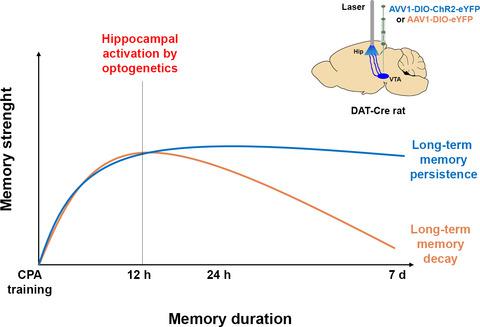当前位置:
X-MOL 学术
›
Eur. J. Neurosci.
›
论文详情
Our official English website, www.x-mol.net, welcomes your feedback! (Note: you will need to create a separate account there.)
The late consolidation of an aversive memory is promoted by VTA dopamine release in the dorsal hippocampus
European Journal of Neuroscience ( IF 3.698 ) Pub Date : 2020-12-07 , DOI: 10.1111/ejn.15076 Cecilia P. Kramar 1 , Fernando Castillo‐Díaz 1 , Eduardo D. Gigante 2 , Jorge H. Medina 1 , M. Flavia Barbano 1, 2
European Journal of Neuroscience ( IF 3.698 ) Pub Date : 2020-12-07 , DOI: 10.1111/ejn.15076 Cecilia P. Kramar 1 , Fernando Castillo‐Díaz 1 , Eduardo D. Gigante 2 , Jorge H. Medina 1 , M. Flavia Barbano 1, 2
Affiliation

|
The hippocampus has been implicated in the processing and storage of aversive memories but the precise mechanisms by which these memories persist in time remain elusive. We have demonstrated that dopaminergic neurotransmission in the dorsal hippocampus regulates the long‐term storage of both appetitive and aversive memories at a critical time point known as “late consolidation” (12 hr after the learning experience). This modulation appears to have opposite effects depending on the valence of the stimuli, with hippocampal dopamine release peaking immediately and 13–17 hr after a rewarding experience. Here, we determined the release pattern of hippocampal dopamine following an aversive experience, in order to better understand this opposite modulation process. We observed significant increases in dopamine levels at several times (6–8, 11–12, and 15 hr) after subjecting rats to a conditioned place aversion (CPA) task with the aversive agent lithium chloride (LiCl). Early pharmacological blockade of hippocampal DA receptors impaired CPA memory consolidation. In addition and consistent with previous findings showing that late post‐training infusions of dopaminergic agents into the hippocampus modulate the long‐term storage of aversive memories, we found that the photostimulation of dopaminergic VTA fibers in the dorsal hippocampus 11–12 hr after CPA training was enough to transform a short‐lasting long‐term memory into a long‐lasting one. The fact that the persistence of an aversive memory can still be affected several hours after the learning experience opens new avenues to develop behavioral and pharmacological strategies for the treatment of a variety of mental disorders.
中文翻译:

VTA多巴胺在背侧海马中的释放促进了厌恶记忆的晚期巩固
海马已经牵涉到厌恶性记忆的处理和存储,但是这些记忆在时间上持续存在的精确机制仍然难以捉摸。我们已经证明,在称为“后期巩固”的关键时间点(学习经验后12小时),背侧海马中的多巴胺能神经传递调节了食性和厌恶性记忆的长期存储。取决于刺激的效价,这种调节似乎具有相反的作用,海马多巴胺释放立即并在有益的经历后13-17小时达到峰值。在这里,我们确定了厌恶经历后海马多巴胺的释放模式,以便更好地了解这种相反的调节过程。我们观察到多巴胺水平在数次显着增加(6-8、11-12,并在15个小时后)用厌恶剂氯化锂(LiCl)对大鼠进行条件性地避开(CPA)任务。海马DA受体的早期药理学障碍损害了CPA记忆巩固。此外,与先前的研究结果表明训练后向海马中多巴胺能药物的后期注入可调节厌恶记忆的长期存储相一致,我们发现CPA训练后11-12小时,多巴胺能VTA纤维对背侧海马的光刺激足以将短暂的长期记忆转变为持久的记忆。学习经历后的几个小时,厌恶记忆的持久性仍会受到影响,这一事实为开发用于治疗各种精神障碍的行为和药理策略开辟了新途径。
更新日期:2021-02-15
中文翻译:

VTA多巴胺在背侧海马中的释放促进了厌恶记忆的晚期巩固
海马已经牵涉到厌恶性记忆的处理和存储,但是这些记忆在时间上持续存在的精确机制仍然难以捉摸。我们已经证明,在称为“后期巩固”的关键时间点(学习经验后12小时),背侧海马中的多巴胺能神经传递调节了食性和厌恶性记忆的长期存储。取决于刺激的效价,这种调节似乎具有相反的作用,海马多巴胺释放立即并在有益的经历后13-17小时达到峰值。在这里,我们确定了厌恶经历后海马多巴胺的释放模式,以便更好地了解这种相反的调节过程。我们观察到多巴胺水平在数次显着增加(6-8、11-12,并在15个小时后)用厌恶剂氯化锂(LiCl)对大鼠进行条件性地避开(CPA)任务。海马DA受体的早期药理学障碍损害了CPA记忆巩固。此外,与先前的研究结果表明训练后向海马中多巴胺能药物的后期注入可调节厌恶记忆的长期存储相一致,我们发现CPA训练后11-12小时,多巴胺能VTA纤维对背侧海马的光刺激足以将短暂的长期记忆转变为持久的记忆。学习经历后的几个小时,厌恶记忆的持久性仍会受到影响,这一事实为开发用于治疗各种精神障碍的行为和药理策略开辟了新途径。



























 京公网安备 11010802027423号
京公网安备 11010802027423号